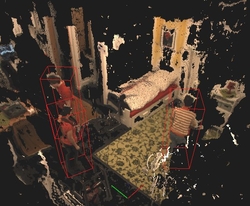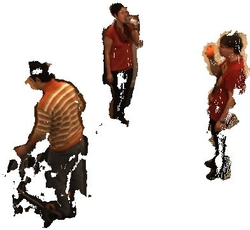Person Detection and Localisation
with RGB-D Data
Person detection by means of optical sensors opens up a wide range of applications:
- Automatic monitoring of public areas
- Customer behaviour and personal attendance in retail as well as in public institutions (museums, clubs, etc.)
- Pedestrian detection in the automotive industry
- AAL (Ambient Assisted Living): Measuring a person's mobility, making social contacts, etc.
With the help of person detection algorithms it is possible to determine the number of people in a room as well as their respective three-dimensional position and extent. Fig. 1 shows the results of an algorithm that processes RGB-D data. The position data are validated with the help of a reference measurement system.
Fig. 2 shows an example application in the area of AAL.
Using the position data, long-term statistics on a person's location and duration can be generated.
The location inside the home, the times the person spends outside the home and the mobility, i.e. how often and how long the person is moving/circulating, can be recorded and evaluated later.
The analysis of the statistics, for example by the attending physician, can give information about strong changes to the usual daily routine or apparent reduction in mobility of a person living alone.
The reasons for this may be a change in the state of health.
With the help of the possibility of a later analysis by a doctor, a change in the condition of a person can be determined, which might have gone unnoticed under certain circumstances.
Pose Estimation with RGB-D Data
In addition to the position of a person, the rough posture (standing, sitting, lying) of the person is recognized using methods of machine learning. Fig. 3 shows the points extracted from the point cloud and associated with the respective persons. Based on these points, a person's pose can be determined using meaningful feature vectors (Fig. 4).
The inclusion of information on physical maintenance in long-term statistics allows more accurate conclusions to be drawn about a person's mobility. In addition, various movements of daily life, such as the movement of a bottle to the mouth, are learned and recognized.
Publications
| Title | Author(s) | Year | |
|---|---|---|---|
| 1 | Activity Recognition for Elderly Care by Evaluating Proximity to Objects and Human Skeleton Data
Pattern Recognition: Applications and Methods, 5th International Conference, ICPRAM 2016, Rome, Italy, February 24-26, 2016, Revised Selected Papers. - Cham, Schweiz : Springer International Publishing, 2017, S. 139 - 155. - Lecture Notes in Computer Science; 10163 |
Richter, Julia Wiede, Christian Dayangac, Enes Shahenshah, Ahsan Hirtz, Gangolf |
2017 |
| 2 | Activity Recognition based on High-Level Reasoning - An Experimental Study Evaluating Proximity to Objects and Pose Information
5th International Conference on Pattern Recognition Applications and Methods, 24.-26.02.2016, Rome, Italy, S. 415-422 |
Richter, Julia Wiede, Christian Dayangac, Enes Heß, Markus Hirtz, Gangolf |
2016 |
| 3 | Pose Estimation and Movement Detection for Mobility Assessment of Elderly People in an Ambient Assisted Living Application
Pattern Recognition: Applications and Methods, 4th International Conference, ICPRAM 2015, Lisbon, Portugal, January 10-12, 2015, Revised Selected Papers. - Cham, Schweiz : Springer International Publishing, 2015, S. 172 - 184. - Lecture Notes in Computer Science ; 9493 |
Richter, Julia Wiede, Christian Hirtz, Gangolf |
2015 |
| 4 | Optimierung der Pflege demenzkranker Menschen durch intelligente Verhaltensanalyse - Ein Pilotprojekt
Intelligente Technik in der beruflichen Pflege - Von Chancen und Risiken einer Pflege 4.0. - "Wissenstag: Technik für die Pflege von morgen - Chancen und Risiken" 18.11.2014 DGUV Congress Dresden. - 2015 |
Richter, Julia Meinel, Lars Findeisen, Michel Hirtz, Gangolf |
2015 |
| 5 | Integration technischer Assistenzsysteme in das häusliche Wohnumfeld am Beispiel des Projektes OPDEMIVA
MATI Mensch - Architektur - Technik - Interaktion für demografische Nachhaltigkeit. - Dresden : Fraunhofer IRB Verlag, 2015, S. 150 - 151 |
Richter, Julia Meinel, Lars Heß, Markus Apitzsch, André Weisleder, Stefan Findeisen, Michel Wiede, Christian Hirtz, Gangolf |
2015 |
| 6 | Mobility Assessment of Demented People Using Pose Estimation and Movement Detection - An Experimental Study in the Field of Ambient Assisted Living
ICPRAM International Conference on Pattern Recognition Applications and Methods, 10-12 January 2015, Lisbon, pp. 22-29 |
Richter, Julia Wiede, Christian Hirtz, Gangolf |
2015 |
| 7 | Assessment and Care System Based on People Detection for Elderly Suffering From Dementia
International Conference on Consumer Electronics (ICCE-Berlin), 07.09.2014 - 10.09.2014, Berlin, S. 59 - 63 |
Richter, Julia Findeisen, Michel Hirtz, Gangolf |
2014 |
| 8 | Novel Methods for Feature Extraction Based on Motion History Images and Evaluation with Regard to Altering Viewing Angles
2013 IEEE Third International Conference on Consumer Electronics Berlin (ICCE-Berlin), 8. - 11. September 2013, Berlin, S. 335-339, 2013 |
Richter, Julia Hirtz, Gangolf |
2013 |




